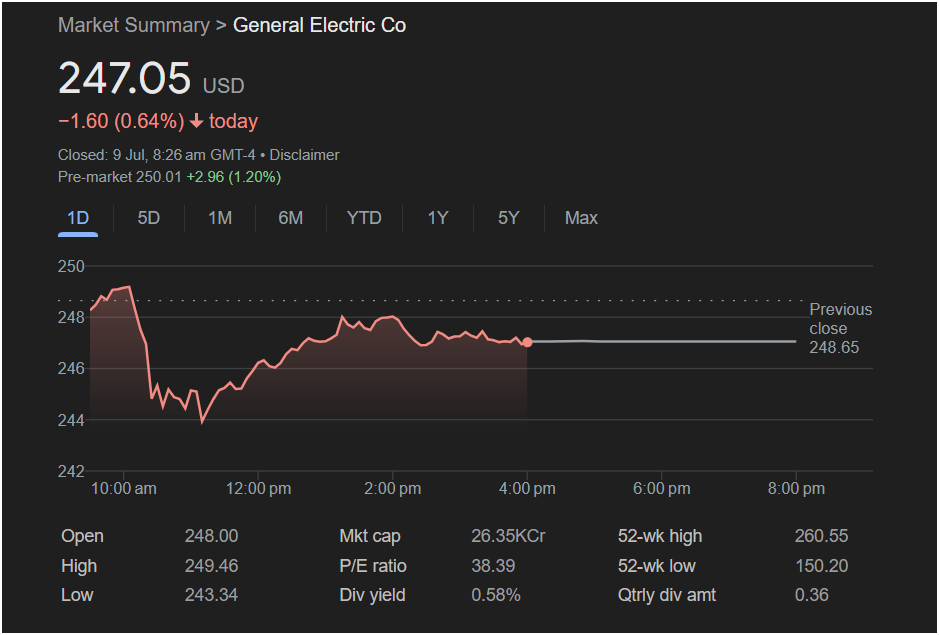The Crucible of Change: A Deep Dive into a Volatile Day for the New General Electric

For more than a century, General Electric (NYSE: GE) was not just a company; it was the quintessential symbol of American industrial might, a sprawling empire whose light bulbs, jet engines, and financial instruments shaped the modern world. Its subsequent fall from grace was just as epic—a slow, painful decline that became a cautionary tale of hubris and complexity. Now, in the final act of a dramatic, multi-year turnaround, a leaner, more focused GE is emerging from the ashes. The stock market screenshot from this one trading day is a perfect, compressed drama of this transformation. A closing price of $247.05, down a modest $1.60 (0.64%), belies the wild intraday swings and the fierce battle between the ghosts of GE’s past and the promise of its future.
This is not a story about a simple down day. It is a narrative of a stock that plunged violently at the open, only to stage a powerful and resilient recovery, demonstrating a newfound conviction among investors. It is the story of a company whose valuation metrics present a fascinating puzzle—a growth-like P/E ratio of over 38 attached to a 130-year-old industrial titan. And most revealingly, it is the story of a stock that, after closing in the red, surged dramatically in pre-market trading, completely reversing the day’s loss and signaling a powerful undertow of bullish optimism.

Chapter 1: The Anatomy of a Reversal – A Story of Fear and Fortitude
A stock chart is a narrative written in real-time. The intraday chart for General Electric on this day tells a gripping story of a morning panic followed by an afternoon of resolute defiance. It was a day that tested the nerve of every GE shareholder and ultimately provided a powerful testament to the market’s growing belief in the company’s turnaround.
1.1 The Morning Shockwave: A Plunge from the Open
The day began on a negative note. GE opened at $248.00, slightly below the previous close of $248.65. But this small dip was just the prelude. From the open, the stock made a brief, feeble attempt to rally to a high of $249.46 before sellers took complete control. In the first 90 minutes of trading, the stock was hit with a wave of intense selling pressure, sending it plummeting to the day’s low of $243.34.
This represents a sharp drop of over $6, or about 2.5%, from the day’s high. This was not a slow drift; it was a panicked sell-off. What could trigger such a violent morning plunge? It was likely the market’s muscle memory kicking in. For over a decade, GE was a stock that consistently disappointed. Any hint of broader market weakness or negative sector news would often hit GE disproportionately hard. The morning’s sellers were likely a mix of:
-
Profit-Takers: The 52-week range of $150.20 – $260.55 shows the stock had already had a massive run. Investors who had ridden that rally might have used the slightest hint of weakness as an excuse to lock in substantial gains.
-
Skeptics of the Turnaround: Many long-term market watchers remain deeply skeptical of GE’s ability to execute its complex break-up. They would see any rally as an opportunity to sell or initiate short positions.
-
Macroeconomic Fears: As a major industrial company, GE is sensitive to fears of a global recession. Any negative data point on manufacturing, trade, or GDP could have triggered a flight from cyclical stocks like GE.
This morning plunge was the “old GE” story playing out—the fear, the doubt, the expectation of failure.
1.2 The Midday Climb from the Abyss: The Bulls Mount a Counter-Offensive
At the moment of maximum pessimism, around the $243 level, the narrative of the day pivoted dramatically. The precipitous fall was met by a wave of determined buying. The chart shows a powerful V-shaped recovery beginning before noon and continuing throughout the afternoon. This was not a weak, tentative bounce; it was a sustained and confident climb.
This recovery is the most significant part of the day’s trading. It signals a fundamental shift in how the market views GE. In the past, such a morning drop might have led to a full-day rout. On this day, it was seen as a buying opportunity. The buyers who stepped in were likely institutional investors with a long-term conviction in the turnaround story. Their thinking was likely:
-
The Culp Premium: A belief in CEO Larry Culp’s ability to execute his plan and unlock value.
-
The Break-Up Value: A focus on the sum-of-the-parts valuation, believing that the three separate companies (Aerospace, Healthcare, Vernova) would be worth more apart than the current conglomerate is worth together.
-
Fundamental Strength: A focus on the underlying strength in key businesses, particularly the post-pandemic recovery in Aerospace.
The stock climbed steadily off its lows, clawing back most of its losses. It was a tug-of-war between the old fears and the new optimism, and by the afternoon, the optimists were clearly winning the ground battle. The stock closed at $247.05, still down on the day, but the character of the trading had changed completely.
1.3 The Resounding Afterword: A Bullish Pre-Market Surge
The true verdict on the day’s battle came after the closing bell. The screenshot, captured the following morning, shows a stunning development: “Pre-market 250.01 +2.96 (1.20%)”. This is a powerful and significant move. It indicates that in the low-volume after-hours and pre-market sessions, the bullish momentum not only continued but accelerated.
This pre-market surge completely erased the previous day’s 0.64% loss and then some. It signaled that the V-shaped recovery was not just a temporary reprieve but the dominant, underlying trend. A catalyst, perhaps a positive analyst note reaffirming the turnaround story or a specific piece of good news for the aerospace industry, had poured fuel on the fire of the afternoon’s optimism. The day’s trading, which ended in the red, was reframed as a successful “bear trap”—a test of the lows that ultimately shook out weak hands and paved the way for a powerful move higher. It was a definitive statement that for this new GE, dips are now for buying.
Chapter 2: The Fall and Rise of an American Icon
To appreciate the significance of a single day’s resilience in GE’s stock, one must understand the depth of the abyss from which it has climbed. The story of GE in the 21st century is one of the most dramatic cautionary tales in modern corporate history—a story of an empire’s decline and the monumental effort to salvage its future.
2.1 The “Welch” Era: The Cult of the Conglomerate
Under the legendary leadership of CEO Jack Welch from 1981 to 2001, GE became the most valuable and admired company in the world. Welch transformed GE from a staid industrial manufacturer into a dynamic, aggressive conglomerate. He championed the “Six Sigma” quality program and a ruthless “rank and yank” performance culture. He expanded GE into a dizzying array of businesses, from the NBC television network to plastics and, most consequentially, financial services.
GE Capital, the company’s financial arm, was the engine of Welch’s success. It grew into a massive, unregulated bank, using the pristine credit rating of the industrial parent to borrow cheaply and make loans on everything from aircraft leases to commercial real estate. By the end of Welch’s tenure, GE Capital was generating nearly half of the company’s profits, and GE’s stock price soared.
2.2 The Immelt Era and the Unraveling
Jeff Immelt, who succeeded Welch in 2001, inherited an empire at its peak. But the foundation was already cracked. The dot-com bust and the 9/11 attacks immediately hit GE’s businesses. More importantly, the complexity and opacity of GE Capital’s balance sheet became a major liability.
The 2008 Global Financial Crisis was the moment the empire broke. As a massive lender with huge exposure to the collapsing real estate market, GE Capital was brought to its knees. The company’s stock plummeted, it was forced to take a bailout from Warren Buffett, and it had to slash its sacred dividend—a devastating blow to its reputation.
The decade that followed was one of painful, slow-motion decline. Immelt tried to pivot GE back to its industrial roots, selling off most of GE Capital and making large acquisitions in the energy sector (like Alstom), which proved to be disastrously timed. The company was plagued by accounting scandals, missed earnings targets, and a collapsing stock price. By 2018, GE, once the symbol of American capitalism, was unceremoniously booted from the Dow Jones Industrial Average, the index it had been a part of for over a century.
2.3 The Culp Revolution: Dismantling the Empire to Save It
In 2018, in a historic move, GE’s board appointed Larry Culp as the first outsider to ever run the company. Culp, who had built a stellar reputation for his successful transformation of the industrial company Danaher, immediately brought a new sense of urgency and discipline.
He focused relentlessly on two things:
-
Deleveraging: Tackling GE’s mountain of debt by selling off assets, including its biopharma business and aircraft leasing arm.
-
Operational Excellence: Implementing the “Lean” manufacturing philosophy—a rigorous focus on continuous improvement and waste elimination—across GE’s sprawling factories.
But his most audacious move was announced in 2021: the complete break-up of General Electric. The plan was to dismantle the 130-year-old conglomerate into three separate, independent, publicly traded companies: GE HealthCare (spun off in early 2023), GE Vernova (comprising the power and renewable energy businesses), and GE Aerospace (the remaining core of the company). This was the ultimate admission that the conglomerate model championed by Welch was dead. It is this radical, high-stakes surgery that underpins the entire turnaround story and the market’s newfound optimism.
Chapter 3: Decoding the Dashboard – A New Valuation for a New GE
The financial data on the screenshot is the quantitative evidence of GE’s transformation. The numbers reflect a company that is being re-evaluated and re-priced by the market, shedding its old identity as a troubled value stock and taking on the characteristics of a focused, industrial growth story.
3.1 Market Cap: 26.35KCr – The Scale of the Remnant
The market cap notation “26.35KCr” (likely a display anomaly) points to a company with a massive valuation. Based on the stock price and shares outstanding, the market cap at the time of this screenshot was in the vicinity of $270 billion. This is still a colossal figure, placing it among the largest industrial companies in the world. However, it is a shadow of its former peak valuation, which once topped $600 billion. The current valuation reflects the company after it has shed numerous businesses, most notably the recent spin-off of GE HealthCare. It is the market’s bet on the future value of the remaining Aerospace and Vernova businesses.
3.2 P/E Ratio: 38.39 – The Growth Multiple
This is the most startling number on the dashboard and the key to the modern GE investment thesis. A Price-to-Earnings ratio of over 38 is highly unusual for a mature industrial company. Historically, GE traded at a much lower multiple. This elevated P/E signifies a profound shift in market perception.
-
Forward-Looking Valuation: The market is not valuing GE on its messy, transitional past earnings. It is looking ahead to what the company will become. The high P/E is a bet on the future earnings power of a standalone GE Aerospace, which is a high-margin, high-growth business that a standalone P/E in the 20s or 30s.
-
Quality over Quantity: By shedding the lower-growth, lower-margin businesses (like much of the Power portfolio and, before that, Healthcare), the “quality” of GE’s remaining earnings stream is perceived to be much higher, thus deserving a higher multiple.
-
The Culp Premium: The market is assigning a significant premium for Larry Culp’s leadership and his proven ability to create shareholder value through operational improvements and strategic actions.
-
A New Peer Group: As it transforms into a pure-play aerospace and defense company, investors are beginning to value it against peers like Raytheon, Safran, and TransDigm, which typically command higher multiples than diversified industrial conglomerates.
This high P/E is also a source of risk. It means the stock is priced for a successful execution of the final spin-off and continued strength in the aerospace market. Any stumbles could lead to a rapid contraction of this multiple.
3.3 Dividend Yield: 0.58% – A Symbol of Recovery
The dividend yield of 0.58%, based on a quarterly payout of $0.36, is small. However, its very existence is symbolically huge. During its darkest days, GE slashed its dividend to a mere penny per share, a humiliating blow for a company that was once a bedrock holding for income investors. The reinstatement of a more meaningful (though still small) dividend is a powerful signal from management of their confidence in the company’s improving cash flow and financial stability. It is a sign that the crisis is over and that a disciplined approach to capital returns is back on the table.
3.4 52-Week Range: $150.20 – $260.55 – The Turnaround Rally
This range tells the story of a stock reborn. The massive rally of over 70% from the low to the high is a graphic representation of the market’s growing embrace of the Culp-led transformation. The low near $150 likely represents the period of peak skepticism about the break-up plan. The powerful ascent to the high near $260 shows the market gaining confidence as each step of the turnaround (the GE HealthCare spin-off, improving cash flow, recovery in aviation) was successfully executed. The day’s trading, occurring near the top of this range, is a natural sign of a stock consolidating after a massive move, with the V-shaped recovery suggesting the underlying uptrend remains firmly intact.
Chapter 4: The Three Pillars of the Future – Aerospace, Vernova, and Healthcare
Larry Culp’s grand vision is to replace a dysfunctional conglomerate with three strong, independent, and focused public companies. Understanding these three pillars is essential to understanding the value proposition of GE today and tomorrow.
1. GE HealthCare (Ticker: GEHC) – The Stable Foundation
-
The Business: Spun off in early 2023, GE HealthCare is a leading global player in medical technology. Its core businesses are Imaging (MRI machines, CT scanners, X-ray equipment), Ultrasound, Patient Care Solutions (monitors, incubators), and Pharmaceutical Diagnostics (imaging agents used in scans).
-
The Investment Thesis: This is a stable, high-margin business with recurring revenue streams from service contracts and consumables. It operates in an industry with long-term tailwinds from an aging global population and increasing demand for healthcare. As a standalone company, it can now focus its capital and R&D on its own growth without competing with the needs of a jet engine factory. Its successful spin-off was the first major proof point of Culp’s break-up strategy.
2. GE Vernova (Power & Renewables) – The Turnaround Challenge
-
The Business: Set to be spun off in early 2024, Vernova will combine GE’s Power and Renewable Energy businesses. The Power segment is a global leader in gas turbines that generate a significant portion of the world’s electricity. The Renewables segment includes one of the world’s largest onshore and offshore wind turbine businesses, as well as grid solutions.
-
The Investment Thesis: This is the most challenging piece of the GE puzzle. The gas turbine business is a mature, cash-generating business with a large and profitable service backlog. However, the renewable energy industry has been plagued by intense price competition, supply chain disruptions, and razor-thin profit margins. The central challenge for Vernova’s leadership will be to make the wind business consistently profitable. Success here is key to unlocking the full value of the GE break-up, but it remains the biggest “prove it” story for investors.
3. GE Aerospace – The Crown Jewel
-
The Business: After the Vernova spin-off, the remaining company will be renamed GE Aerospace. This is, by far, GE’s best and most profitable business. It is one of the world’s two dominant manufacturers of commercial jet engines (in a duopoly with Pratt & Whitney) and a major supplier of engines for military aircraft.
-
The Investment Thesis: This is the primary engine of the bull case for GE. Its business model is a classic “razor-and-blades” model. It often sells new engines (the “razor”) at a small profit or even a loss, but it makes enormous, high-margin profits for decades from servicing those engines (the “





